Shaolin Temple Blu-ray Movie
HomeShaolin Temple Blu-ray Movie 
Shǎo lín sì / 少林寺Arrow | 1976 | 117 min | Not rated | No Release Date
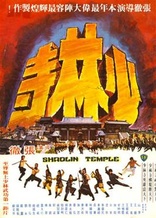
Price
Movie rating
6.8 | / 10 |
Blu-ray rating
| Users | 0.0 | |
| Reviewer | 3.0 | |
| Overall | 3.0 |
Overview
Shaolin Temple (1976)
The Shaolin Temple begins to accept outside students seeking to learn the superior techniques of the Shaolin kung fu, amidst some bad omens foretelling the future of the Temple.
Starring: Sheng Fu, Kuan-Chun Chi, Sheng Chiang, Lung-Wei Wang, Phillip Chung-Fung KwokDirector: Cheh Chang, Wu Ma
| Foreign | Uncertain |
| Martial arts | Uncertain |
| Action | Uncertain |
| Adventure | Uncertain |
Specifications
Video
Video codec: MPEG-4 AVC
Video resolution: 1080p
Aspect ratio: 2.36:1
Original aspect ratio: 2.39:1
Audio
Mandarin: DTS-HD Master Audio Mono
English: DTS-HD Master Audio Mono
Subtitles
English, English SDH
Discs
Blu-ray Disc
Single disc (1 BD)
Playback
Region A (B, C untested)
Review
Rating summary
| Movie | 3.0 | |
| Video | 4.0 | |
| Audio | 3.5 | |
| Extras | 4.0 | |
| Overall | 3.0 |
Shaolin Temple Blu-ray Movie Review
Reviewed by Jeffrey Kauffman December 28, 2021 Note: This film is available on Blu-ray as part of
Shawscope Volume One.
If the Shaw Brothers' logo is intentionally reminiscent of the Warner Brothers' logo, there are a number of other connective tethers between the two
sets of siblings. The Warners founded what would become one of the "Big Five" studios in the American filmmaking industry in 1923, after having
had
some success as exhibitors. They went on to create one of the crown jewels of the "studio system" in the United States, eventually matriculating
pretty forcefully into the television side of things, even when some of their American competitors were not in such a huge rush to "help the enemy".
Somewhat similarly, the Shaw Brothers formed the first version of their moviemaking empire just two years after the Warners, in 1925,
though admittedly it took until 1958 for the organization to be called Shaw Brothers. Like the Warners, the Shaws had begun as venue
owners, though in their case they dealt in both film exhibitions (courtesy of their father) and live theater. Kind of interestingly, given one
of
the Warner's technological triumphs, the introduction of sound with 1929's The Jazz Singer, the Shaws are credited with having brought the "talkie" era to Chinese cinema in 1932 and 1933.
The
Shaws took a while to develop what many think of as their stock in trade, the kung fu films that started appearing in the seventies, but there's little
disagreement that their involvement in that genre massively helped to popularize it, much as the Warners had helped to make the so-called
"gangster
film" must see cinema in the 1930s. Again, understandably somewhat later than the Warners ventured into television in the 1950s, the Shaws
ultimately actually forsook the bulk of their movie output to concentrate on productions for the small screen. But Arrow is concentrating on some of
the studio's feature films from its perceived heyday, with the Volume One of this set's title hinting that fans may be just at the beginning
of
an exciting viewing adventure. As is often the case with these deluxe Arrow releases, the packaging is impressive and the supplemental features
are bountiful and outstanding.
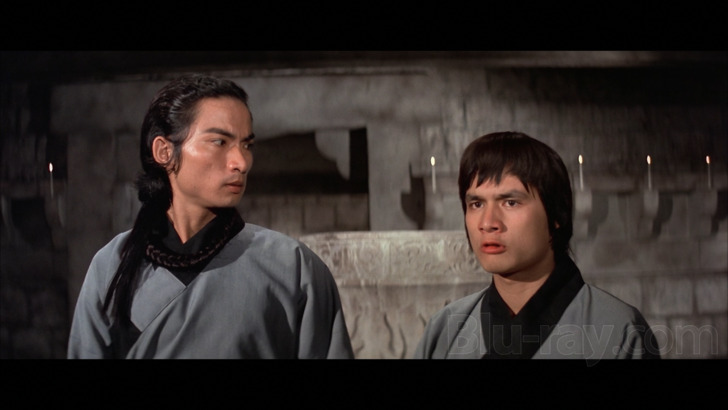
Five Shaolin Masters may have made some mistakes in opening the film with the destruction of the titular temple of this film, leaving some viewers to wonder what led up to that point, information that Five Shaolin Masters frankly struggles to provide. While this effort attempts to get into some of "the rest of the story", this film also may strike some as a precursor to The Five Venoms in much the same way that Five Shaolin Masters may.
There are a number of interesting elements to this story, including the induction of various would be members into temple life, and some of the internecine strife that starts accruing among those who have been accepted. There's arguably a bit more emphasis in this film on the dynamic between the Shaolin Temple adherents and Qing warriors, and as usual for a Shaw Brothers epic, the fighting tends to ramp up over the course of the film, leading to a maelstrom between factions that caps things. Perhaps due to the prevalence of testosterone fueled action, there's not much in the way of a romantic angle in this film.
Shaolin Temple Blu-ray Movie, Video Quality 
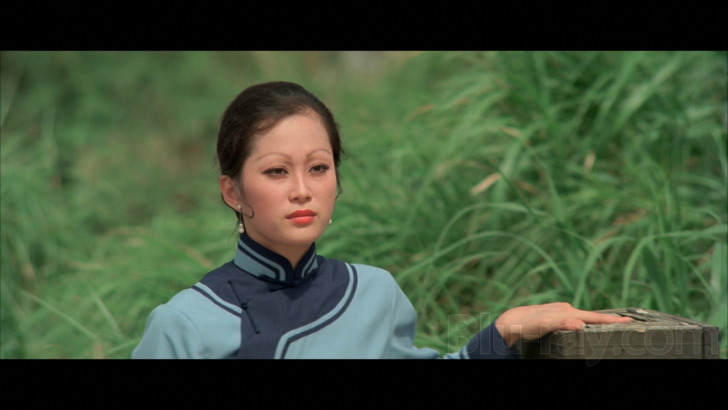
Shaolin Temple is presented on Blu-ray courtesy of Arrow Video with an AVC encoded 1080p transfer in 2.36:1. Arrow's nicely appointed insert pamphlet sized booklet contains quite a bit of information, though all of the films have been lumped together on one page, as follows:
All twelve films in this boxset are presented in their original 2.35:1 aspect ratios [sic] with their original Mandarin, English and Cantonese (where applicable) monoaural soundtracks. Every effort has been made to present these films in their original and complete versions using the best materials available.While this was restored by Celestial Pictures as was Five Shaolin Masters, to my eyes this is a better looking transfer overall. Color temperature is much more consistent, and in fact things pop really beautifully (look at the lush colors in screenshot 2 for just one example). While detail levels are probably not at the same levels as in the first two films in this set, they arguably trump those in Five Shaolin Masters, and fine detail on things like costumes tends to be quite good, even in some midrange shots. Grain resolves naturally (this doesn't have the same quasi- digital appearance that can be spotted in Five Shaolin Masters), and there are also no real compression issues in some other potential "trouble" spots, like the torrential downpour that is experienced by three candidates for temple membership. There are no major signs of age related wear and tear.
Five Shaolin Masters, Shaolin Temple, Mighty Peking Man, Executioners from Shaolin, Heroes of the East and the shorter Alternate Version of Chinatown Kid were remastered by Celestial Pictures in 2003-2007, as part of an initiative to digitally restore the entire Shaw Brothers library. The High Definition masters of these restorations, which included the original Mandarin and English mono soundtracks, were supplied to Arrow Films by Celestial Pictures.
King Boxer, The Boxer from Shantung, Challenge of the Masters, The Five Venoms, Crippled Avengers, Dirty Ho and the longer international cut of Chinatown Kid have all been newly restored by Arrow Films in 2021, in collaboration with L'Immagine Ritrovata, Hong Kong Film Archive and Celestial Pictures.
The original 35mm negatives for King Boxer, The Boxer from Shantung, Challenge of the Masters, The Five Venoms, Crippled Avengers and Dirty Ho were scanned at L'Immagine Rittrovata Asia and restored in 2K resolution at L'Immagine Ritrovata, Bologna. The Films were graded at R3Store Studios, London. These restorations have used the entire film negative without resorting to the practice of "frame cutting" resulting in the loss of film frames at each negative splice point.
The mono mixes were remastered from the original sound negatives at L'Immagine Ritrovata. Additional sound remastering was completed by Matthew Jarman/Bad Princess Productions. The audio synch will often appear loose against the picture, due to the fact that the dialogue and sound effects were recorded entirely in post production, as per the production standards of the period.
A 35mm internegative of the International Version of Chinatown Kid was scanned at L'Immagine Ritrovata Asia and restored in 2K resolution at L'Immagine Ritrovata, Bologna. The film was graded at R3Store Studios, London.
The mono mix was remastered from the original sound negative at L'Immagine Ritrovata. Additional sound remastering was completed by Matthew Jarman/Bad Princess Productions.
An additional scene from Chinatown Kid missing from the original elements was scanned from a vintage 35mm print and graded in 2K resolution at American Genre Film Archive (AGFA).
All original materials supplied for these restorations were made available from the Hong Kon Film Archive via Celestial Pictures.
Shaolin Temple Blu-ray Movie, Audio Quality 
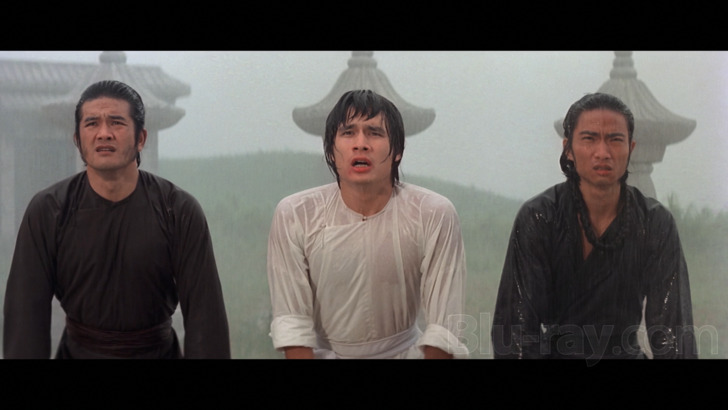
Shaolin Temple features DTS-HD Master Audio Mono tracks in either Mandarin or English. As is my standard operating procedure, I toggled between the two as I watched the film, and this is another audio presentation where the Mandarin sounds more full bodied and hotter. There's some slight background hiss at times, and the same kind of slightly hollow sound accompanying both dialogue and effects in particular, but all spoken material is delivered clearly and cleanly. Optional English subtitles are available.
Shaolin Temple Blu-ray Movie, Special Features and Extras 
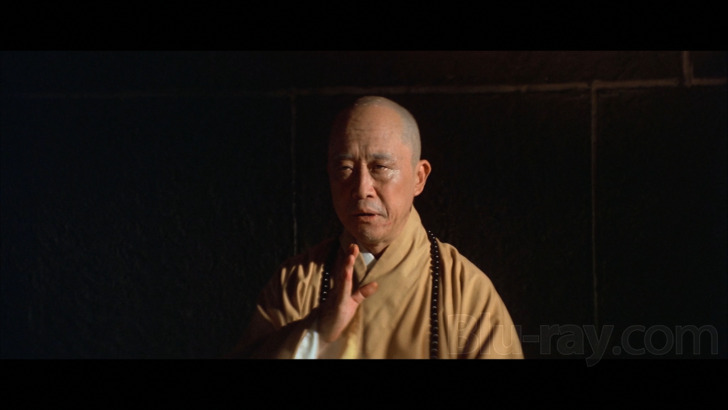
Arrow has packaged this release with Five Shaolin Masters and Shaolin Temple on the same disc. Arrow has rather nicely authored the disc so that when choosing either film, a specific set of supplements is accessible, albeit with some shared content (as with regard to the Rayns piece, below, which is available under both films' Special Features submenus).
- Tony Rayns on Chang Cheh (HD; 36:46) is another newly done piece featuring that always interesting Rayns, here discussing the legendary director.
- Elegant Trails features two actor profiles produced by Celestial Pictures in 2003. Subtitled in English.
- Ti Lung (HD; 9:30)
- David Chiang (HD; 8:04)
- Standard Definition Version (2:01:57) is offered with the kind of weird but slightly humorous description that despite this being in standard definition, it may be a "truer representation of how the film looked on its original theatrical release". Despite the way this is labeled, this is actually presented in 720p.
- Alternate Opening Credits
- HK Theatrical Credits (HD; 2:12)
- US Theatrical Credits (HD; 1:39)
- Alternate English Title Sequence (HD; 00:43)
- Trailer Gallery
- HK Theatrical Trailer (HD; 3:54)
- German Theatrical Trailer (HD; 2:40)
- Digital Reissue Trailer (HD; 1:00)
- Image Gallery (HD)
Shaolin Temple Blu-ray Movie, Overall Score and Recommendation 
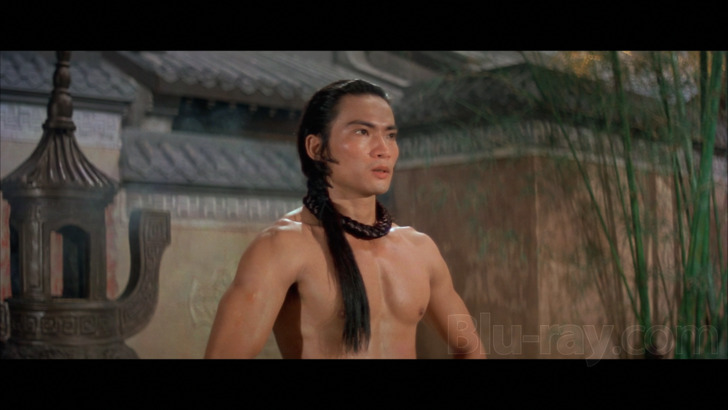
Hindsight is, of course, 20/20, but this particular story might have been clearer had Shaolin Temple actually come first. This has a generally more energetic narrative than Five Shaolin Masters, and its technical merits are arguably a bit better as well. As usual with Arrow's releases, the supplemental package is outstanding, for those who may be considering making a purchase.
Similar titles
Similar titles you might also like
(Still not reliable for this title)

Crippled Avengers
Return of the 5 Deadly Venoms
1978

Executioners from Shaolin
The Executioners of Death / Hong Xi Guan
1977

King Boxer
Five Fingers of Death / Tian xia di yi quan
1972

Five Shaolin Masters
5 Masters of Death
1974

Challenge of the Masters
Liu A-Cai yu Huang Fei-Hong
1976

Dirty Ho
Lan tou He
1979

The Boxer from Shantung
1972

Heroes of the East
1978

Chinatown Kid
1977

The Five Deadly Venoms
The Five Venoms / 五毒 / Wu du
1978

Five Superfighters
Tang shan wu hu / 唐山五虎
1979

The Mighty Peking Man
Goliathon
1977

Mad Monkey Kung Fu
Feng hou / 瘋猴
1979

Martial Arts of Shaolin
Nan bei Shao Lin / 南北少林
1986

Invincible Shaolin
Nan Shao Lin yu bei Shao Lin / 南少林與北少林
1978

Return to the 36th Chamber
少林搭棚大師 / Shao Lin da peng da shi
1980

The Bare-Footed Kid
Chi jiao xiao zi / Chik geuk siu ji / 赤腳小子
1993

Disciples of the 36th Chamber
Pi li shi jie / 霹靂十傑
1985

My Young Auntie
Zhang bei / 長輩
1981

The Boxer's Omen
Mo / 魔
1983